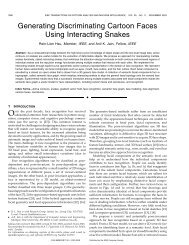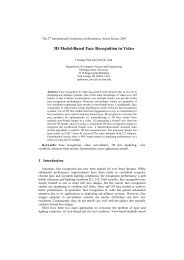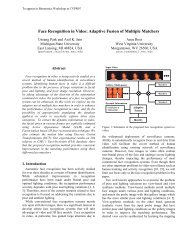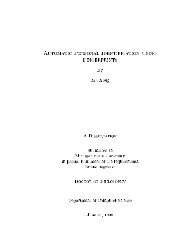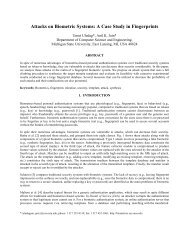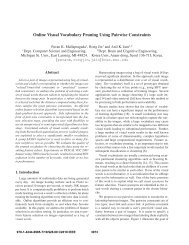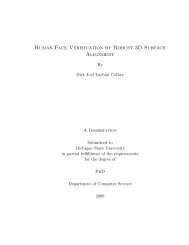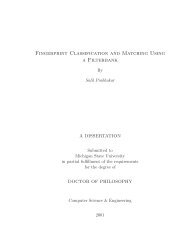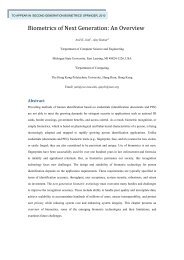Face Detection and Modeling for Recognition - Biometrics Research ...
Face Detection and Modeling for Recognition - Biometrics Research ...
Face Detection and Modeling for Recognition - Biometrics Research ...
You also want an ePaper? Increase the reach of your titles
YUMPU automatically turns print PDFs into web optimized ePapers that Google loves.
(a) (b) (c) (d)<br />
Figure 5.6. Shadow maps: (a) <strong>and</strong> (c) are luma components of face images in Figs.<br />
5.4(a) <strong>and</strong> 5.4(c), overlaid with rectangles within which the average values of skin<br />
intensity is calculated; (b) <strong>and</strong> (d) are shadow maps where bright pixels indicate the<br />
regions that are darker than average skin intensity.<br />
representations. The explicit contour representation has the advantage of maintaining<br />
the geometric topology. The implicit contour representation requires topological<br />
constraints on the implicit function.<br />
5.3.1 Interacting Snakes <strong>and</strong> Energy Functional<br />
Active contours have been successfully used to impose high-level geometrical constraints<br />
on low-level features that are extracted from images. Active contours are<br />
iteratively de<strong>for</strong>med based on the initial configuration of the contours <strong>and</strong> the energy<br />
functional that is to be minimized. The initial configuration of interacting snakes is<br />
obtained from the coarsely-aligned semantic face graph, <strong>and</strong> is shown in Fig. 5.8(c).<br />
Currently, there are eight snakes interacting with each other. These snakes describe<br />
the hair outline, face outline, eyebrows, eyes, nose, <strong>and</strong> mouth of a face; they are<br />
denoted as V (s) = ⋃ N<br />
j=1 {v i(s)}, where N (= 8) is the number of snakes, <strong>and</strong> v i (s) is<br />
the i th snake with the parameter s ∈ [0, 1].<br />
The energies used <strong>for</strong> minimization include the internal energy of a contour (i.e.,<br />
smoothness <strong>and</strong> stiffness energies), <strong>and</strong> the external energy (i.e., the inverse of edge<br />
120



